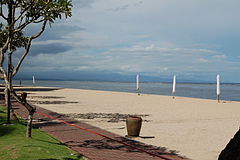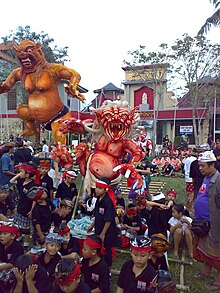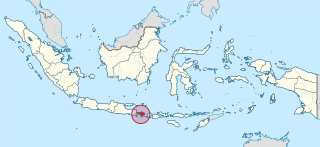
Bali is a province of Indonesia and the westernmost of the Lesser Sunda Islands. East of Java and west of Lombok, the province includes the island of Bali and a few smaller offshore islands, notably Nusa Penida, Nusa Lembongan, and Nusa Ceningan to the southeast. The provincial capital, Denpasar, is the most populous city in the Lesser Sunda Islands and the second-largest, after Makassar, in Eastern Indonesia. The upland town of Ubud in Greater Denpasar is considered Bali's cultural centre. The province is Indonesia's main tourist destination, with a significant rise in tourism since the 1980s, and becoming an Indonesian area of overtourism. Tourism-related business makes up 80% of the Bali economy.

Gamelan is the traditional ensemble music of the Javanese, Sundanese, and Balinese peoples of Indonesia, made up predominantly of percussive instruments. The most common instruments used are metallophones and a set of hand-drums called kendang, which keep the beat. The kemanak, a banana-shaped idiophone, and the gangsa, another metallophone, are also commonly used gamelan instruments on Bali. Other notable instruments include xylophones, bamboo flutes, a bowed string instrument called a rebab, and a zither-like instrument called a siter, used in Javanese gamelan. Additionally, vocalists may be featured, being referred to as sindhen for females or gerong for males.

Balinese Hinduism is the form of Hinduism practised by the majority of the population of Bali. This is particularly associated with the Balinese people residing on the island, and represents a distinct form of Hindu worship incorporating local animism, ancestor worship or Pitru Paksha, and reverence for Buddhist saints or Bodhisattava.

The Balinese people are an Austronesian ethnic group native to the Indonesian island of Bali. The Balinese population of 4.2 million live mostly on the island of Bali, making up 89% of the island's population. There are also significant populations on the island of Lombok and in the easternmost regions of Java.

Pendet dance a traditional dance from Bali, Indonesia, in which floral offerings are made to purify the temple or theater as a prelude to ceremonies or other dances. Pendet is typically performed by young girls, carrying bowls of flower petals, handfuls of which are cast into the air at various times in the dance. Pendet can be thought of as a dance of greeting, to welcome the audience and invite spirits to enjoy a performance. It is one of the oldest Balinese dance, although the current form was codified in the 1950s.

Hinduism is the third-largest religion in Indonesia, based on civil registration data in 2022 from Ministry of Home Affairs, is practised by about 1.69% of the total population, and almost 87% of the population in Bali. Hinduism was the dominant religion in the country before the arrival of Islam and is one of the six official religions of Indonesia today. Hinduism came to Indonesia in the 1st-century through Indian traders, sailors, scholars and priests. A syncretic fusion of pre-existing Javanese folk religion, culture and Hindu ideas, that from the 6th-century also synthesized Buddhist ideas as well, evolved as the Indonesian version of Hinduism. These ideas continued to develop during the Srivijaya and Majapahit empires. About 1400 CE, these kingdoms were introduced to Islam from coast-based Muslim traders, and thereafter Hinduism, which was previously the dominant religion in the region, mostly vanished from many of the islands of Indonesia.

Galungan is a Balinese holiday celebrating the victory of dharma over adharma. It marks the time when the ancestral spirits visit the Earth. The last day of the celebration is Kuningan, when they return. The date is calculated according to the 210-day Balinese Pawukon calendar.
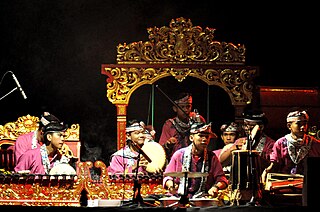
Gamelan beleganjur is one of the most popular styles of gamelan music in Bali. Its closest Western analogue is probably the Western military band.

Balinese dance is an ancient dance tradition that is part of the religious and artistic expression among the Balinese people of Bali island, Indonesia. Balinese dance is dynamic, angular, and intensely expressive. Balinese dancers express the stories of dance-drama through bodily gestures including gestures of fingers, hands, head, and eyes.

Dance in Indonesia reflects the country's diversity of ethnicities and cultures. There are more than 1,300 ethnic groups in Indonesia. Austronesian roots and Melanesian tribal forms are visible, and influences ranging from neighboring Asian and even western styles through colonization. Each ethnic group has its own dances: there are more than 3,000 original dance forms in Indonesia. The old traditions of dance and drama are being preserved in the numerous dance schools which flourish not only in the courts but also in the modern, government-run or supervised art academies.

Ogoh-ogoh are statues built for the Ngrupuk parade, which takes place on the eve of Nyepi day in Bali, Indonesia. Ogoh-ogoh normally take the form of mythological beings, mostly demons. As with many creative endeavours based on Balinese Hinduism, the creation of Ogoh-ogoh represents spiritual aims inspired by Hindu philosophy.

The Bali Aga, Baliaga, or Bali Mula are the indigenous people of Bali. Linguistically they are an Austronesian people. Bali Aga people are predominantly located in the eastern part of the island, in Bangli, Buleleng and Karangasem, but they can also be found in north-western and central regions. Bali Aga people who are referred to as Bali Pergunungan are those that are located at Trunyan village. For the Trunyan Bali Aga people, the term Bali Aga is regarded as an insult with an additional meaning of "the mountain people that are fools"; therefore, they prefer the term Bali Mula instead.

A total solar eclipse took place at the Moon's descending node of the orbit on March 8–9, 2016. If viewed from east of the International Date Line, the eclipse took place on March 8 (Tuesday) and elsewhere on March 9 (Wednesday). A total solar eclipse occurs when the Moon's apparent diameter is larger than the Sun's and the apparent path of the Sun and Moon intersect, blocking all direct sunlight and turning daylight into darkness; the Sun appears to be black with a halo around it. Totality occurs in a narrow path across Earth's surface, with the partial solar eclipse visible over a surrounding region thousands of kilometres wide. The eclipse of March 8–9, 2016 had a magnitude of 1.0450 visible across an area of Pacific Ocean, which started in the Indian Ocean, and ended in the northern Pacific Ocean.
The Balinese saka calendar is one of two calendars used on the Indonesian island of Bali. Unlike the 210-day pawukon calendar, it is based on the phases of the Moon, and is approximately the same length as the tropical year.

An Odalan is a Balinese village temple festival in Indonesia. It is an occasion when the Hindu village community comes together, invite the gods to visit them for three or more days, perform religious services together offering refreshments and entertainment. It is a periodic event, one that celebrates Balinese Hindu heritage and performance arts. The Odalan celebrations are a social occasion among Indonesian Hindus, and have historically contributed to the rich tradition of theatre and Balinese dance forms.
Ngejot refers to the Hindu ritual of giving food to neighbors as a gesture of gratitude, usually during times of celebrations or holidays.

Omed-omedan, also known as "The Kissing Ritual", is a ceremony that is held by the young people of Banjar Kaja Sesetan, Denpasar, Bali. Omed-omedan is held on the day of ngembak geni to celebrate the Saka new year. The name is derived from the Balinese language and means pull-pull.
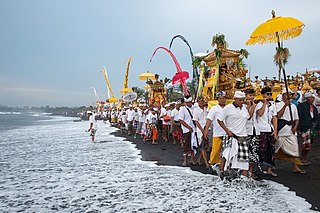
Melasti is a Hindu Balinese purification ceremony and ritual, which, according to the Balinese calendar, is held several days prior to the Nyepi holy day. It is observed by Hindus in Indonesia, especially in Bali. Melasti was meant as the ritual to cleanse the world from all the filth of sin and bad karma through the symbolic act of acquiring the Tirta Amerta, "the water of life".
Pecalang are a type of local "traditional" security officers of an administrative village in Bali, Indonesia. Throughout Indonesia, they are uniquely present in Bali only and usually are engaged in mundane tasks such as assisting traffic control, but during large events are tasked with general security. They work in coordination with other state security and law enforcement agencies, which are the Satpol PP and the police. Pecalangs are local security bodies and report only to the village head, a Kepala Desa. Pecalangs are not modern phenomena created for tourism; rather, Bali had hansip and pecalang security bodies for hundreds of years before the advent of modern tourism. These forces traditionally reported to one of the royal families of the historic Bali Kingdoms, also considered as their eyes and ears.
